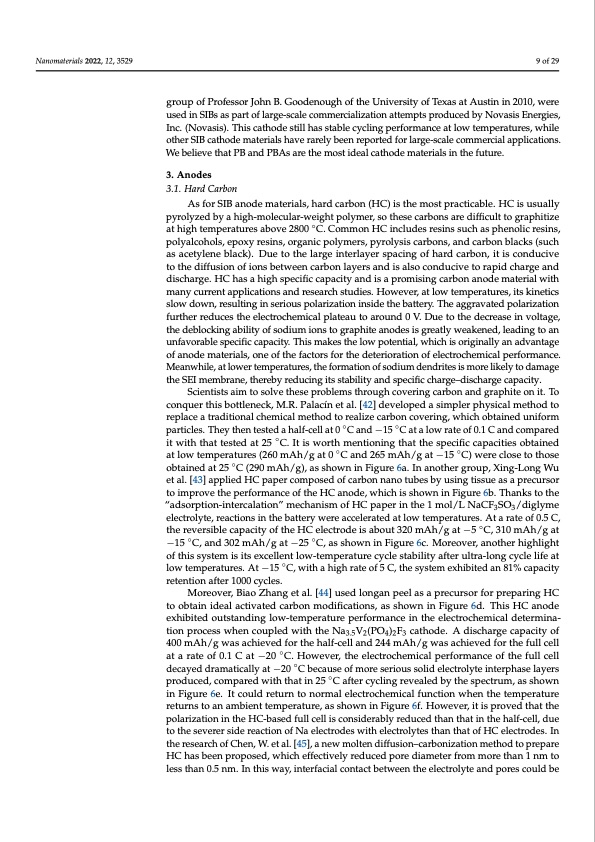
PDF Publication Title:
Text from PDF Page: 009
Nanomaterials 2022, 12, 3529 9 of 29 group of Professor John B. Goodenough of the University of Texas at Austin in 2010, were used in SIBs as part of large-scale commercialization attempts produced by Novasis Energies, Inc. (Novasis). This cathode still has stable cycling performance at low temperatures, while other SIB cathode materials have rarely been reported for large-scale commercial applications. We believe that PB and PBAs are the most ideal cathode materials in the future. 3. Anodes 3.1. Hard Carbon As for SIB anode materials, hard carbon (HC) is the most practicable. HC is usually pyrolyzed by a high-molecular-weight polymer, so these carbons are difficult to graphitize at high temperatures above 2800 ◦C. Common HC includes resins such as phenolic resins, polyalcohols, epoxy resins, organic polymers, pyrolysis carbons, and carbon blacks (such as acetylene black). Due to the large interlayer spacing of hard carbon, it is conducive to the diffusion of ions between carbon layers and is also conducive to rapid charge and discharge. HC has a high specific capacity and is a promising carbon anode material with many current applications and research studies. However, at low temperatures, its kinetics slow down, resulting in serious polarization inside the battery. The aggravated polarization further reduces the electrochemical plateau to around 0 V. Due to the decrease in voltage, the deblocking ability of sodium ions to graphite anodes is greatly weakened, leading to an unfavorable specific capacity. This makes the low potential, which is originally an advantage of anode materials, one of the factors for the deterioration of electrochemical performance. Meanwhile, at lower temperatures, the formation of sodium dendrites is more likely to damage the SEI membrane, thereby reducing its stability and specific charge–discharge capacity. Scientists aim to solve these problems through covering carbon and graphite on it. To conquer this bottleneck, M.R. Palacín et al. [42] developed a simpler physical method to replace a traditional chemical method to realize carbon covering, which obtained uniform particles. They then tested a half-cell at 0 ◦C and −15 ◦C at a low rate of 0.1 C and compared it with that tested at 25 ◦C. It is worth mentioning that the specific capacities obtained at low temperatures (260 mAh/g at 0 ◦C and 265 mAh/g at −15 ◦C) were close to those obtained at 25 ◦C (290 mAh/g), as shown in Figure 6a. In another group, Xing-Long Wu et al. [43] applied HC paper composed of carbon nano tubes by using tissue as a precursor to improve the performance of the HC anode, which is shown in Figure 6b. Thanks to the “adsorption-intercalation” mechanism of HC paper in the 1 mol/L NaCF3SO3/diglyme electrolyte, reactions in the battery were accelerated at low temperatures. At a rate of 0.5 C, the reversible capacity of the HC electrode is about 320 mAh/g at −5 ◦C, 310 mAh/g at −15 ◦C, and 302 mAh/g at −25 ◦C, as shown in Figure 6c. Moreover, another highlight of this system is its excellent low-temperature cycle stability after ultra-long cycle life at low temperatures. At −15 ◦C, with a high rate of 5 C, the system exhibited an 81% capacity retention after 1000 cycles. Moreover, Biao Zhang et al. [44] used longan peel as a precursor for preparing HC to obtain ideal activated carbon modifications, as shown in Figure 6d. This HC anode exhibited outstanding low-temperature performance in the electrochemical determina- tion process when coupled with the Na3.5V2(PO4)2F3 cathode. A discharge capacity of 400 mAh/g was achieved for the half-cell and 244 mAh/g was achieved for the full cell at a rate of 0.1 C at −20 ◦C. However, the electrochemical performance of the full cell decayed dramatically at −20 ◦C because of more serious solid electrolyte interphase layers produced, compared with that in 25 ◦C after cycling revealed by the spectrum, as shown in Figure 6e. It could return to normal electrochemical function when the temperature returns to an ambient temperature, as shown in Figure 6f. However, it is proved that the polarization in the HC-based full cell is considerably reduced than that in the half-cell, due to the severer side reaction of Na electrodes with electrolytes than that of HC electrodes. In the research of Chen, W. et al. [45], a new molten diffusion–carbonization method to prepare HC has been proposed, which effectively reduced pore diameter from more than 1 nm to less than 0.5 nm. In this way, interfacial contact between the electrolyte and pores could bePDF Image | Na Ion Batteries Used at Low Temperatures

PDF Search Title:
Na Ion Batteries Used at Low TemperaturesOriginal File Name Searched:
nanomaterials-12-03529-v4.pdfDIY PDF Search: Google It | Yahoo | Bing
Salgenx Redox Flow Battery Technology: Salt water flow battery technology with low cost and great energy density that can be used for power storage and thermal storage. Let us de-risk your production using our license. Our aqueous flow battery is less cost than Tesla Megapack and available faster. Redox flow battery. No membrane needed like with Vanadium, or Bromine. Salgenx flow battery
| CONTACT TEL: 608-238-6001 Email: greg@salgenx.com | RSS | AMP |